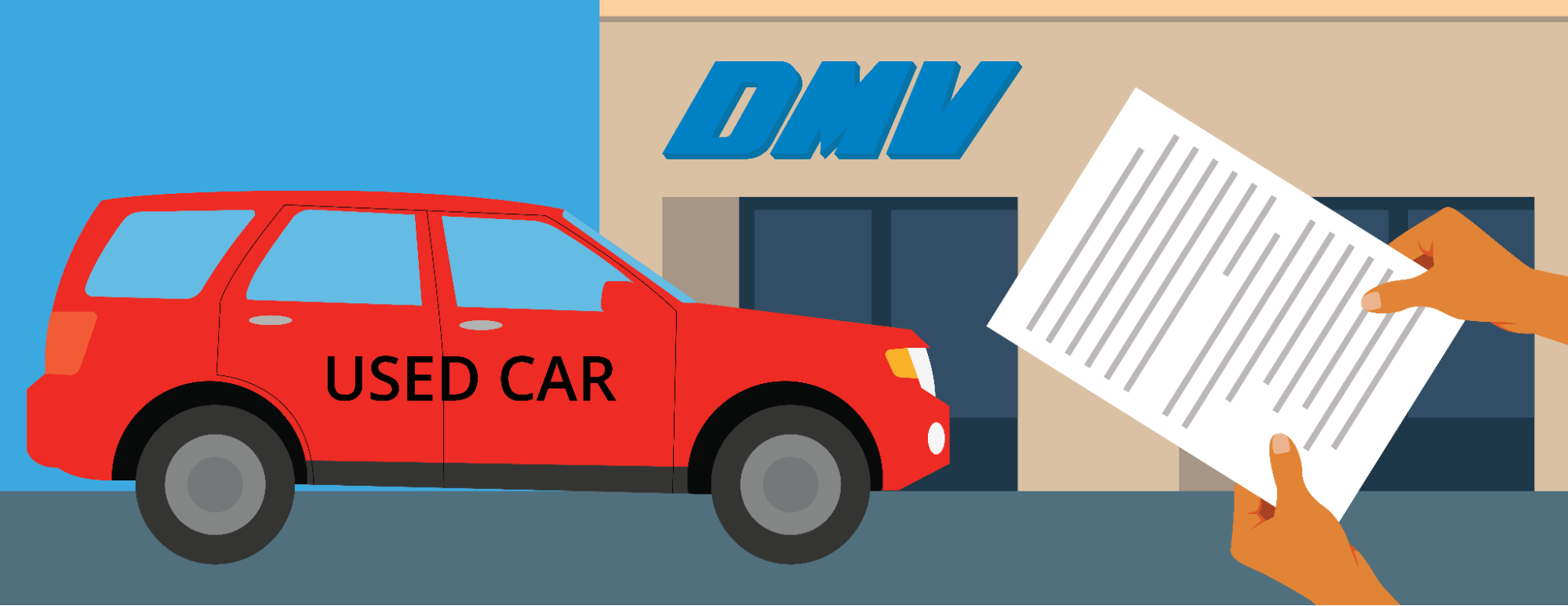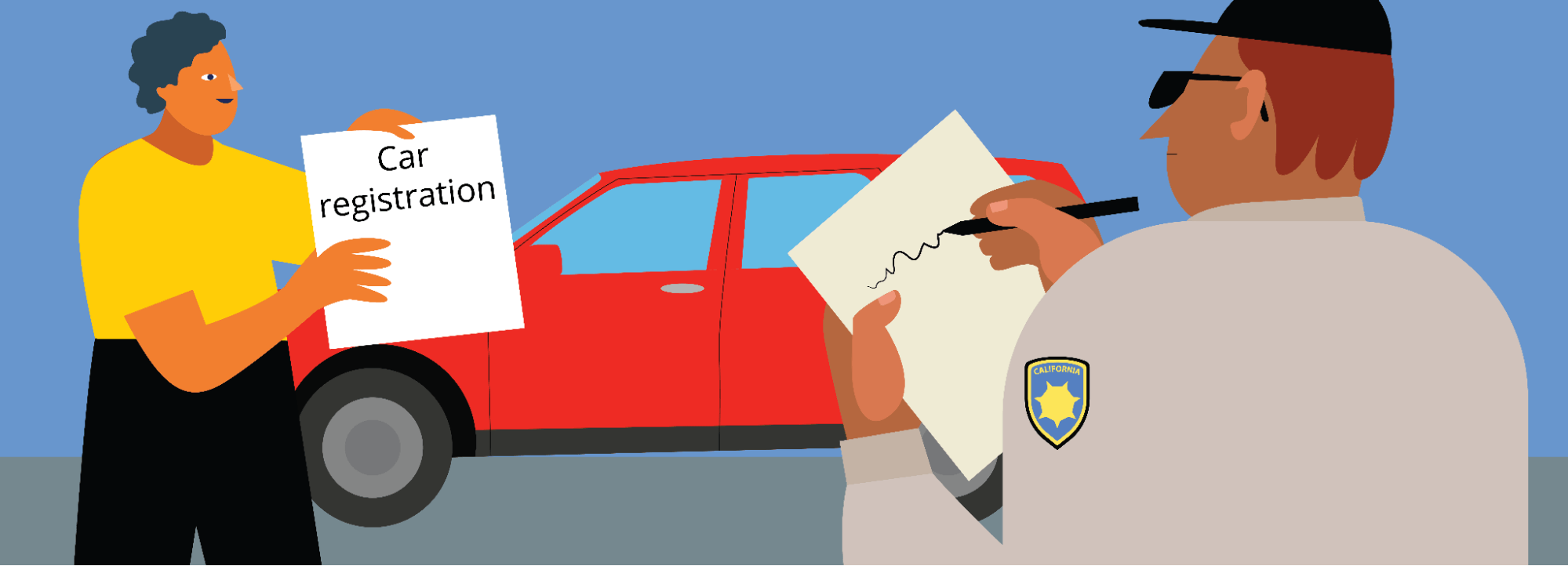In California, you’re legally required to register your car within 10 to 20 days from the date of purchase. Similar rules apply to out-of-state vehicle registrations, which must be completed within 20 days from the date you establish residency or get a job in the state.
No matter your circumstances, it’s necessary to visit a local DMV location and file some paperwork. The only way to bypass these steps is to purchase from a dealership, which will handle things on your behalf.
Here’s everything you should know about California vehicle registration.
Do You Need to Register Your Car in California?
Per California law, you must register your vehicle with the DMV unless you’re a tourist, nonresident student, or military member on duty.
You must register your car in California if you:
- Become a California resident
- Buy a personal or business car, trailer, or tow dolly
- Bring a vehicle from another state
- Get a job or rent a home in California
What You Need to Register a Vehicle in California
To register a vehicle in California, you will need:
- Vehicle title (signed by seller)
- Bill of sale (if applicable)
- Completed REG 343 (Application for Title or Registration)
- Odometer disclosure (REG 262, if needed)
- Smog check certificate (if required)
- VIN verification (for out-of-state vehicles)
- Proof of California auto insurance
- Proof of California residency (if you’re a new resident)
- Valid photo ID (like a driver’s license)
- Payment for registration fees
How to Register a Vehicle Purchased from a Dealership
Most dealerships in California will transfer the title and do the paperwork for you. This is true for both new and used cars.
Your car dealership will also give you temporary license plates. These are valid for 90 days, and, by the time they expire, you should get your permanent license plates.
If you buy from a dealership that doesn’t offer these services, then you must register the car yourself within 10 days from the purchase date. This will look much like the process below.
Traffic school can help you keep a clean driving record, prevent insurance increases, and more!
How to Register a Used Vehicle Purchased from a Private Party

When you purchase a car from another person, you must transfer ownership to your name within 10 days. Simply follow these steps:
- Transfer the title: Ask the seller to sign the vehicle title and hand it over to you. Sign the document, then proceed to the next step. If the title is missing, fill out Form REG 227 (Application for Replacement or Transfer of Title).
If the name on the title is different from the seller’s name, you must get a bill of sale before registering the car. Make sure this document is signed by both parties — the vehicle’s owner and the seller. - Fill out the application form: Complete Form REG 343 (Application for Title or Registration) with information about you and your new car.
- Get a smog certificate: In California, the seller of a used vehicle must provide the buyer with a valid smog certificate at the time of sale. This certificate is valid for 90 days.
- Exemptions:
- Gasoline-powered vehicles that are four model years old or newer do not need a smog certificate during a sale. Instead, the buyer pays a smog transfer fee.
- Vehicles eight model years old or newer are exempt from biennial smog checks but must pay a smog abatement fee during registration renewal.
- Fully electric vehicles are exempt from smog inspection requirements.
- Exemptions:
- Submit your odometer reading: Fill out Form REG 262 or disclose the odometer reading on the title if the car you bought is newer than 10 years old.
- Show proof of insurance: Purchase minimum liability insurance prior to registering the vehicle. The DMW will want to see a valid insurance ID card, whether physical or digital.
- Pay the necessary fees: Vehicle registration fees start at $74 and vary from case to case. For example, you may have to pay extra for special license plates.
- Visit a DMV office: Book an appointment with the DMV to register the car in your name. Bring the necessary documents and pay any applicable fees online, in person, by mail, over the phone, or at a DMV kiosk.
- Obtain a Temporary Operating Permit (TPO): A temporary operating permit (TOP) allows you to drive your car while waiting for the license plates and stickers to arrive by mail. A standard TOP (for complete registrations) is valid for 90 days.
How to Register a Vehicle from Out-of-State
Out-of-state vehicle registrations must be completed within 20 days from the date you establish residency or get a job in California. The registration process isn’t much different from when you register an in-state car, except that it involves additional paperwork. Here’s what to do:
- Complete an Application: Fill out the Application for Title or Registration (Form REG 343).
- Vehicle Verification: Have your vehicle inspected by an authorized DMV employee or a peace officer to verify the Vehicle Identification Number (VIN) and ensure it meets California emissions standards.
- Obtain a Smog Inspection: Most vehicles require a smog inspection to meet California’s emissions standards. If your vehicle is less than eight years old, you can just pay a smog abatement fee when you renew your registration.
- Provide Ownership Documents: Submit the out-of-state title or, if unavailable, the current registration and any lienholder information.
- Proof of Insurance: Present evidence of valid California auto insurance.
- Pay Fees: Registration fees vary based on the vehicle’s value, location, and other factors.
Read: Out of State Vehicle Registration in California
How Much Does Vehicle Registration in California Cost?
The California DMV charges a $74 base registration fee for all vehicles, plus additional fees based on factors like:
- Your city or county
- The date you purchased the car
- The vehicle’s declared value or purchase price
- Where you bought the car from (e.g., a licensed California dealer vs. an out-of-state dealership)
- Vehicle condition (new vs. pre-owned)
Expect to shell out up to $700-$800 based on the above factors. The higher the value of your car, the more you’ll pay in fees.
You may use online fee calculators to get a rough estimate, but the exact amount will be determined by DMV personnel at the time of registration.
What Happens If You Don’t Register Your Vehicle?

Failure to register your vehicle can result in a traffic ticket and a fine of $280 plus court and administrative fees. Additionally, you will be charged with an infraction.
Also, note that late registration can result in penalty fees, as shown below:
| If payment is late: | Percentage of vehicle license fee and weight fee | Registration late fee | CHP late fee |
|---|---|---|---|
| 1 – 10 days* |
• 10% of the vehicle license fee due for that year. • 10% of the weight fee due for that year (if any). | $10.00 | $10.00 |
| 11 – 30 days* |
• 20% of the vehicle license fee due for that year. • 20% of the weight fee due for that year (if any). | $15.00 | $15.00 |
| 31 days – one year* |
• 60% of the vehicle license fee due for that year. • 60% of the weight fee due for that year (if any). | $30.00 | $30.00 |
| More than one year – two years |
• 80% of the vehicle license fee due for that year. • 80% of the weight fee due for that year (if any). | $50.00 | $50.00 |
| More than two years |
• 160% of the vehicle license fee due for that year. • 160% of the weight fee due for that year (if any). | $100.00 | $100.00 |
Additional charges may apply if you fail to pay the registration fees on time. These penalties can run into hundreds of dollars, depending on how late you are with the payments.
Renewing Vehicle Registration in California
Your vehicle registration is valid for one year. After that, it’s time to renew. Here’s how to do it.

- Online: California residents can initiate various vehicle registration processes online through the Department of Motor Vehicles (DMV) website. You’ll need your license plate number and VIN number. You should also ensure that the DMV has up-to-date proof of insurance and a smog certification (if required.)
- In person: Schedule an appointment with the DMV to renew your registration. You’ll need your renewal notice or current registration card, proof of insurance, and smog certification, if necessary.
- Via a third party: If you bought your car from a private seller, you can hire an authorized third party like Redline Registration, NeedTags, or the AAA to assist you with registration or registration renewal..
Attend Traffic School to Make Vehicle Registration Easy
A poor driving record could prevent you from registering a new vehicle or renewing your registration.
Traffic school can help California drivers charged with one-point traffic offenses, such as running a red light. If you are eligible for traffic school, you can take a short course online or in person to hide the conviction from public view.
Before starting traffic school, you must plead guilty to the charge and pay the fine. Get the court’s approval, then choose a DMV-approved traffic school like ours. This will prevent your insurance rates from increasing after a ticket and help you maintain a clean driving record.
Traffic school courses cover topics like distracted driving, accident prevention, road signs and their meanings, driving maneuvers, right-of-way situations, and more. Their role is to reinforce safe driving habits and reduce traffic law violations.
Our traffic school course is accepted by all California courts and can be completed online from any device, including smartphones. Plus, it’s available in three languages and comes with all sorts of perks, including:
✅ Unlimited exam retakes
✅ Easy-to-follow learning materials
✅ Free English, Chinese, and Spanish audio read-along
✅ Same-day certificate submission to the court and DMV
✅ No credit card required to sign up
✅ Pay nothing until you pass
✅ 24/7 live chat support
99.9% of our students pass the final exam on the first try – and you can do it, too. Start traffic school for FREE today to keep your record in good standing.
FAQs about Vehicle Registration in California
Is there anything else you want to know about vehicle registration in California? Below are the answers to some questions we get from our students.
What can I do if I don’t receive my vehicle registration renewal notice?
The California DMV sends out renewal notices electronically (if you have a MyDMV account) or by mail about two to three months before a registration expires.
Even if you don’t receive a notice, you still need to renew your vehicle registration on time. The DMV doesn’t waive late fees due to a missing renewal notice.
Is there a DMV registration lookup tool for California?
Yes, there is. You can sign up for a MyDMV account and then check your vehicle registration status via the DMV website.
How can I cancel a vehicle’s registration in California?
The steps required to cancel a vehicle’s registration in California depend on your individual circumstances.
If you sell your car, you must complete a Notice of Transfer and Release of Liability (NRL) to notify the DMV about it. In this case, you’ll no longer have to pay the registration renewal fee.
Another option is to apply for Planned Non-Operation (PNO). Basically, you’ll fill out a form to let the DMV know that you won’t drive your car this year, but you plan to store it somewhere (e.g., a garage). This way, you won’t have to pay the registration renewal fee while your vehicle is off the road.
To avoid legal issues, contact the DMV for more information. Describe your situation and ask about the next steps.
Do I need proof of residency to register a car in California?
Yes — you do need to provide proof of California residency when registering a vehicle in the state, but only if you are a new resident or registering a vehicle that was previously titled or registered outside California.
New California residents or those registering an out-of-state vehicle must show proof of residency. You have 20 days from establishing residency to register the car.
If you’re already a California resident and registering a vehicle from within-state (e.g. bought locally), proof of residency is usually not needed unless your address recently changed.
